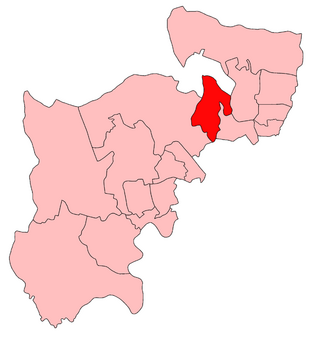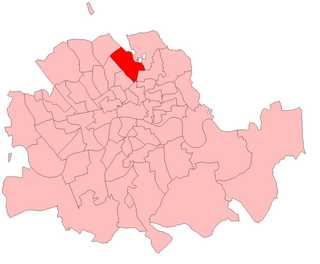Related Research Articles

Birmingham Yardley is a constituency of part of the city of Birmingham represented in the House of Commons of the UK Parliament since 2015 by Jess Phillips of the Labour Party.

Romford is a constituency in Greater London represented in the House of Commons of the UK Parliament since 2001 by Andrew Rosindell, a Conservative.

Finchley was a constituency represented in the House of Commons of the Parliament of the United Kingdom. It elected one Member of Parliament (MP) by first-past-the-post voting; its longest-serving and best-known MP was Margaret Thatcher, Prime Minister from 1979 to 1990. Although boundary changes meant that she never again attained the large majority by which she won in 1959, her constituents nonetheless returned her by comfortable (9,000) majorities at general elections throughout her premiership.
Liverpool Exchange was a borough constituency within the city of Liverpool in England, centred on Liverpool Exchange railway station. It returned one Member of Parliament (MP) to the House of Commons of the Parliament of the United Kingdom, elected by the first past the post system.
Birmingham Aston was a constituency of the House of Commons of the Parliament of the United Kingdom. From 1918 to 1974 it elected one Member of Parliament (MP) by the first-past-the-post system of election.
Luton was a constituency including the town of Luton in Bedfordshire. It returned one Member of Parliament (MP) to the House of Commons of the UK Parliament from 1885 to 1974, elected by the first past the post system.
Birmingham East was a parliamentary constituency in the city of Birmingham, England. It returned one Member of Parliament (MP) to the House of Commons of the Parliament of the United Kingdom, elected by the first-past-the-post voting system.

Islington East was a constituency which returned one Member of Parliament (MP) to the House of Commons of the Parliament of the United Kingdom from 1885, until it was abolished for the February 1974 general election.

Balham and Tooting was a constituency in South London, which returned one Member of Parliament (MP) to the House of Commons of the Parliament of the United Kingdom. It was created for the 1918 general election and abolished for the 1950 general election.

Salford South was a parliamentary constituency in the City of Salford in Greater Manchester from 1885 until 1950. It returned one Member of Parliament (MP) to the House of Commons of the Parliament of the United Kingdom.
Birmingham South was a parliamentary constituency in Birmingham which returned one Member of Parliament (MP) to the House of Commons of the Parliament of the United Kingdom from 1885 until it was abolished for the 1918 general election.
Birmingham West was a parliamentary constituency represented in the House of Commons of the Parliament of the United Kingdom. It returned one Member of Parliament (MP), elected by the first-past-the-post voting system.
Birmingham, Sparkbrook was a parliamentary constituency centred on the Sparkbrook area of Birmingham. It returned one Member of Parliament (MP) to the House of Commons of the Parliament of the United Kingdom, elected by the first past the post system.
Birmingham Small Heath was a parliamentary constituency centred on the Small Heath area of Birmingham. It returned one Member of Parliament (MP) to the House of Commons of the Parliament of the United Kingdom.
Birmingham Handsworth was a parliamentary constituency centred on the Handsworth district of Birmingham. It returned one Member of Parliament (MP) to the House of Commons of the Parliament of the United Kingdom. It was abolished in 1983.
Wandsworth Central was a parliamentary constituency in the Wandsworth district of South London. It returned one Member of Parliament (MP) to the House of Commons of the Parliament of the United Kingdom, elected by the first-past-the-post voting system.

Brixton was a parliamentary constituency centred on the Brixton district of South London. It returned one Member of Parliament (MP) to the House of Commons of the Parliament of the United Kingdom, elected by the first-past-the-post system.
Birmingham Acock's Green was a short-lived constituency of the House of Commons of the Parliament of the United Kingdom from 1945 to 1950. It elected one Member of Parliament (MP) by the first past the post system of election.
Birmingham King's Norton was a constituency of the House of Commons of the Parliament of the United Kingdom from 1918 to 1955. It elected one Member of Parliament (MP) by the first-past-the-post system of election.
Acocks Green ward is an electoral ward in south-east Birmingham, England, and following the boundary reorganisation of 1 December 2017 includes the areas of Acocks Green, Stockfield and Fox Hollies.
References
- ↑ Fraser, Hugh (1918). The Representation of the People Act, 1918: with explanatory notes. London: Sweet and Maxwell.
- ↑ "The House of Commons (Redistribution of Seats) Order 1945. SI 1945/701". Statutory Rules and Orders 1945. Vol. I. London: His Majesty's Stationery Office. 1946. pp. 682–698.
- 1 2 3 4 5 6 7 8 9 British Parliamentary Election Results 1918-1949, FWS Craig
- ↑ Debrett's House of Commons & Judicial Bench, 1922
- ↑ Report of the Annual Conference of the Labour Party, 1939
- Boundaries of Parliamentary Constituencies 1885-1972, compiled and edited by F.W.S. Craig (Parliamentary Reference Publications 1972)
- Craig, F. W. S. (1983) [1969]. British parliamentary election results 1918–1949 (3rd ed.). Chichester: Parliamentary Research Services. ISBN 0-900178-06-X.
- Leigh Rayment's Historical List of MPs – Constituencies beginning with "M" (part 3)